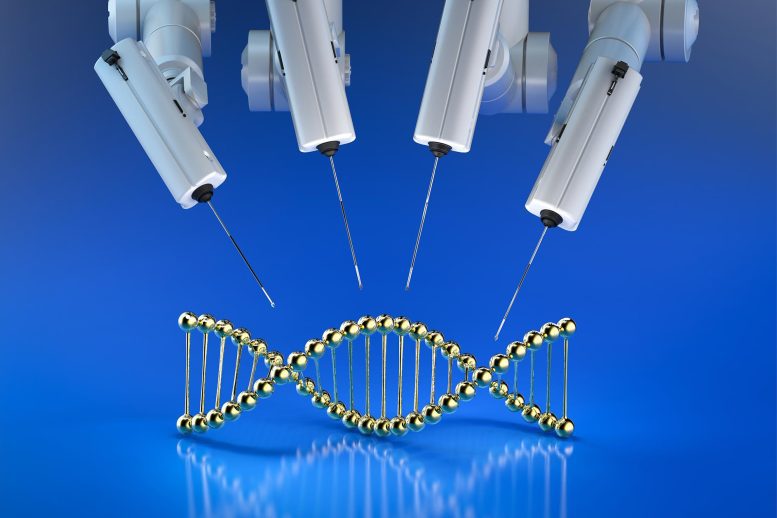
Researchers created a new epigenome editing platform that allows precise control of chromatin marks, showing their direct impact on gene expression and challenging previous understanding of gene regulation mechanisms.
A study from the Hackett group at EMBL Rome led to the development of a powerful epigenetic editing technology, which unlocks the ability to precisely program chromatin modifications.
Understanding how genes are controlled at the molecular level is a central challenge in modern biology. This complex mechanism is mainly driven by the interaction between proteins called transcription factors, DNA regulatory regions, and epigenetic modifications – chemical changes that alter chromatin structure. The set of epigenetic modifications of a cell’s genome is referred to as the epigenome.
Advancements in Epigenome Editing
In a study published today (May 9) in Nature Genetics, scientists from the Hackett Group at European Molecular Biology Laboratory (EMBL) Rome have developed a modular epigenome editing platform – a system to program epigenetic modifications at any location in the genome. The system allows scientists to study the impact of each chromatin modification on transcription, the mechanism by which genes are copied into mRNA to drive protein synthesis.
Chromatin modifications are thought to contribute to the regulation of key biological processes such as development, response to environmental signals, and disease.

Creative depiction of the epigenetic editing toolkit: each building represents the epigenetic state of a single gene (dark windows are silenced genes, lit up windows are active genes). The crane illustrates the epigenetic editing system which enables de novo deposition of chromatin marks on any genomic location. Marzia Munafò
To understand the effects of specific chromatin marks on gene regulation, previous studies have mapped their distribution in the genomes of healthy and diseased cell types. By combining this data with gene expression analysis and the known effects of perturbing specific genes, scientists have assigned functions to such chromatin marks.
However, the causal relationship between chromatin marks and gene regulation has proved difficult to determine. The challenge lies in dissecting the individual contributions of the many complex factors involved in such regulation – chromatin marks, transcription factors, and regulatory DNA sequences.
Breakthrough in Epigenome Editing Technology
Scientists from the Hackett Group developed a modular epigenome editing system to precisely program nine biologically important chromatin marks at any desired region in the genome. The system is based on CRISPR – a widely used genome editing technology that allows researchers to make alterations in specific DNA locations with high precision and accuracy.
Such precise perturbations enabled them to carefully dissect cause-and-consequence relationships between chromatin marks and their biological effects. The scientists also designed and employed a ‘reporter system’, which allowed them to measure changes in gene expression at single-cell level and to understand how changes in the DNA sequence influence the impact of each chromatin mark. Their results reveal the causal roles of a range of important chromatin marks in gene regulation.
Key Points and What Comes Next
For instance, the researchers discovered a new role for H3K4me3, a type of chromatin mark previously thought to be a result of transcription. They found that H3K4me3 can actually increase transcription by itself if added to specific DNA locations artificially.
“This was a very exciting and surprising result that contradicted our expectations,” said Cristina Policarpi, a postdoc in the Hackett Group and the main scientist of the study. “Our data suggest a complex regulatory network, where several governing factors interact to modify gene expression levels in a given cell. These factors include the existing structure of the chromatin, the underlying DNA sequence, and the location in the genome.”
Possible Uses and Future Research
Hackett and colleagues are currently investigating ways to utilize this technology through a promising start-up business. The next step will be to validate and broaden these conclusions by focusing on genes in different cell types and on a large scale. How chromatin marks impact transcription across various genes and downstream mechanisms also needs to be clarified.
“Our modular epigenetic editing toolkit presents a new experimental approach to understand the reciprocal relationships between the genome and epigenome,” said Jamie Hackett, Group Leader at EMBL Rome. “The system could be used in the future to more precisely understand the significance of epigenomic changes in influencing gene activity during development and in human disease. Additionally, the technology allows for the programming of desired gene expression levels in a very adjustable way, which is promising for precision health applications and could prove useful in disease contexts.”
Reference: “Stematic Epigenome Editing Captures the Context-dependent Instructive Function of Chromatin Modifications” 9 May 2024, Nature Genetics.
DOI: 10.1038/s41588-024-01706-w



